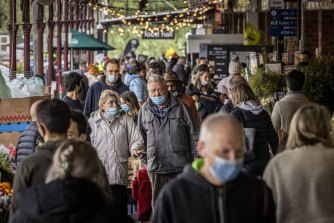Recession fears recede as economy expands more than expected
The Australian economy expanded by a better-than-expected 0.7 per cent through the three months to June, sharply reducing the chances of the nation recording its second recession in two years.
Data from the Australian Bureau of Statistics released on Wednesday showed a big lift in spending by governments and households helped deliver the smallest increase in economic activity since the middle of last year. Economists had tipped growth in the quarter of between 0.1 per cent and 0.6 per cent.

Pre-lockdown shopping helped the economy grow by 0.7 per cent in the June quarter.Credit:Wayne Taylor
Annual growth reached a record 9.6 per cent as last June’s result of minus 7 per cent fell out of the rolling annual result.
Since the ABS started collating GDP figures in 1959, annual growth has only reached 8.3 per cent on three separate occasions, the most recent in the 12 months to June 1984 when the country emerged from a devastating drought.
The result is likely to disappear rapidly, as it predated the string of lockdowns across NSW, Victoria and the ACT which is expected to see the September quarter show a large fall in economic activity.
Overall private demand contributed 1 percentage point to growth while household spending added 0.6 percentage points. There was a lift of 1.3 per cent in spending on services due to relaxed restrictions.
Public demand added 0.7 percentage points to growth on the back of continuing state and federal government infrastructure projects.
Private investment rose by 2 per cent and contributed 0.3 percentage points to growth. Dwelling investment, aided by the federal government’s HomeBuilder scheme, grew by 1.7 per cent.
Growth was reduced, however, by net trade which took 1 percentage point from growth. Inventories cut another 0.2 percentage points while non-dwelling investment reduced growth by 0.1 percentage point.
The economy had grown by an upwardly revised 1.9 per cent through the March quarter.
The bureau’s head of national accounts, Michael Smedes, said domestic spending drove the result.
“Domestic demand drove growth of 0.7 per cent this quarter which saw continued growth across household spending, private investment and public sector expenditure,†he said.
“Lockdowns had minimal impact on domestic demand, with fewer lockdown days and the prolonged stay at home orders in NSW only commencing later in the quarter.â€
State final demand, which effectively measures everything other than imports and exports, grew 2.2 per cent in NSW over the quarter and 1.4 per cent in Victoria. Queensland and WA increased 2 per cent and 1.2 per cent respectively.
In NSW, total final consumption expenditure was up 1.9 per cent due to a jump in household consumption as spending on hotels, cafes and restaurants increased and an increase in government consumption due to more frontline services from state and local government workers.
In Victoria, there was a 0.1 per cent increase in household consumption due to lockdowns in the June quarter.
In both Victoria and NSW there was a significant increase in ownership transfer costs due to a hot housing market.
The household saving ratio decreased to 9.7 per cent, down from 11.6 per cent, but remains at elevated levels.
Shadow treasurer Jim Chalmers said the figures showed the economy was slowing even before the lockdown in Sydney and across Victoria.
“This is slower growth than the United States, United Kingdom and OECD average,†he said.
“The true cost of the Morrison government’s incompetence will be revealed in the September quarter, which covers the ongoing and protracted lockdowns in NSW, Victoria and the ACT.â€
BIS Oxford Economics chief economist Sarah Hunter said the growth momentum had eased over June with the “easy wins†from relaxing restrictions and re-opening the economy already evident in earlier quarters, but the result was stronger than expected.
“The national accounts data is inherently backward-looking, and this is particularly true at the moment given the ongoing lockdowns in NSW, Victoria and the ACT,†Dr Hunter said. She expects a 3 per cent contraction over the September quarter and a “drawn out†recovery into 2022.
CommSec chief economist Craig James, who is tipping a 4 per cent reduction in the current quarter, said the June result was “encouragingâ€.
“Some of the most meaningful statistics at present can’t be found in economics, rather they are the vaccination rates across states and territories. Vaccination is the road out of the crisis, allowing economies to re-open,†he said.
The Morning Edition newsletter is our guide to the day’s most important and interesting stories, analysis and insights. Sign up here.
Shane Wright â€" Shane is a senior economics correspondent for The Age and The Sydney Morning Herald.Connect via Twitter or email.Jennifer Duke is an economics correspondent for The Sydney Morning Herald and The Age, based at Parliament House in Canberra.Connect via Twitter or email.
0 Response to "Recession fears recede as economy expands more than expected"
Post a Comment